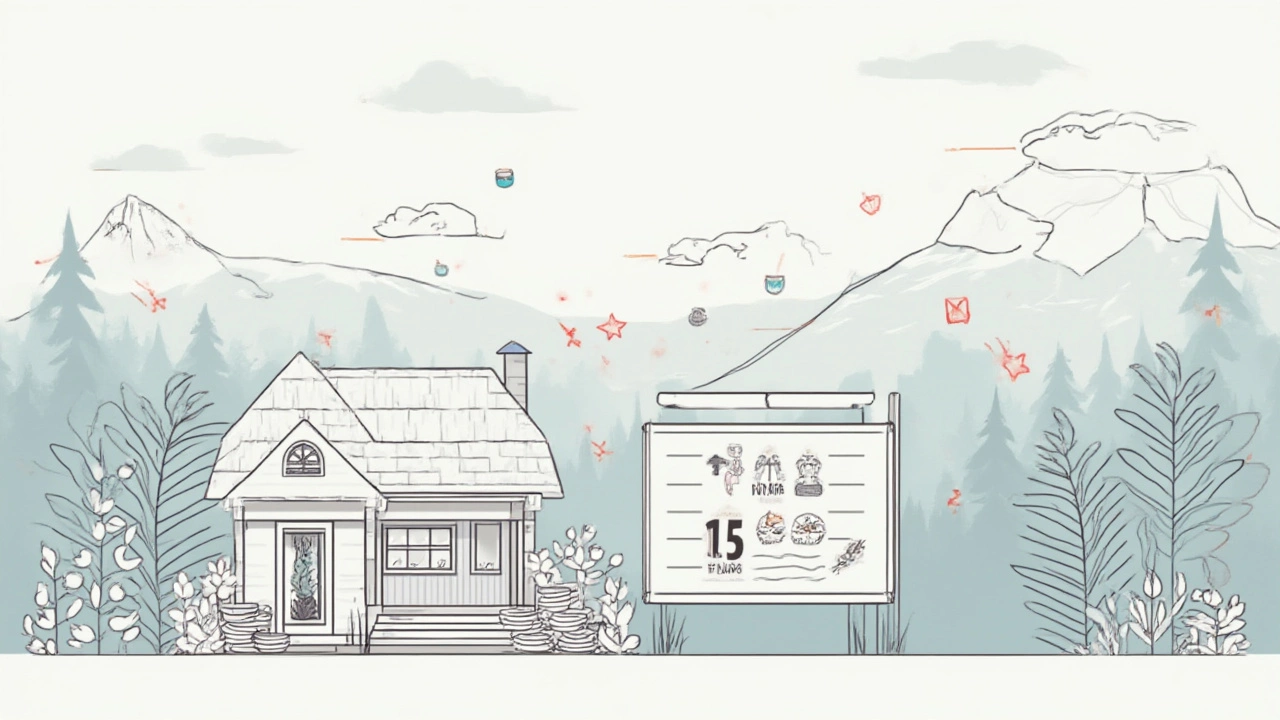Here’s something people almost never tell you—sitting with a mortgage calculator can be just as stressful as scrolling your newsfeed after a bad day. Plug in the numbers, and suddenly your bank account feels a little too real. A $100,000 mortgage over 15 years sounds simple enough, but it’s got more moving parts than most folks expect.
Understanding a 100k Mortgage Over 15 Years: The Basics You Need
No two mortgages work the same, but jumping into a 15-year loan for $100,000 boils down to three core things: loan principal, interest rate, and time. The shortest path to debt freedom is almost always a shorter mortgage term—like 15 versus the usual 25 or 30 years. That means higher monthly payments, but less interest out of your pocket over the life of the loan. In New Zealand, the average bank offers fixed interest rates hovering around 6.5% to 7.5% at the time of writing (July 2025), with some lenders a bit lower for strong borrowers. With a shorter term, more of your payment goes directly toward the loan itself, not just the interest.
Alright, let’s see what the numbers look like. For a $100,000 mortgage, fix it at a tidy 7% annual interest rate (close to the NZ national average in 2025), and you’ll pay about $899 per month. By the end, you’ll have shelled out $61,847 in interest on top of your $100,000—so $161,847, total. Change the interest rate to 6.5%, and your monthly comes down to $872, but the total interest paid is about $56,955. That’s nearly a $5,000 difference for every half-percent change in interest. If you get a better rate, you keep more in your pocket, plain and simple.
| Interest Rate | Monthly Repayment | Total Interest Paid | Total Cost |
|---|---|---|---|
| 6.5% | $872 | $56,955 | $156,955 |
| 7.0% | $899 | $61,847 | $161,847 |
| 7.5% | $927 | $66,899 | $166,899 |
Why not just take a 30-year loan, though? The monthly payment drops to about $665 at 7%, so you’ll sleep a bit easier each month—but you’ll pay $139,339 in interest alone, more than twice as much as with a 15-year loan. If you hate the idea of essentially buying your house twice from the bank, the 15-year option makes sense. Still, that fatter monthly payment can leave your budget feeling tight, so it’s a trade-off between long-term savings and short-term breathing room.
It’s pretty normal for folks to wonder what’s included in those monthly payments. In almost all local banks, your payment gets split between loan principal and interest. Early on, most of the money covers the interest—the bank wants its share first. Over time, as you pay down the loan, the interest portion shrinks, and you make quicker progress on the principal. It’s called amortization. If your rate is variable, that payment can move up or down over time, which is why many people fix their rate for a set period—yes, even though variable options sometimes seem cheaper at first glance.
One more quick point: Kiwis who lease instead of buy often watch renters lose money for decades—they never build up an asset. But if you can stomach the monthly squeeze and hold the property, your equity grows much quicker with a 15-year mortgage. It’s your ticket to real ownership, not just a handshake with the bank that lasts a lifetime.
Hidden Costs, Fees, and Surprises You Should Know
Borrowing $100,000 isn’t just about those meaty repayments. The real cost isn’t always clear until you show up at your lawyer’s office or get an email from the bank. First off, almost every lender charges application or establishment fees—these can range from $200 to $800 in New Zealand. If you’re refinancing or breaking your mortgage early (maybe to chase a better rate), expect to pay break fees, which sometimes run into the thousands if interest rates have dropped since you signed on.
Valuation fees sneak up next—banks often insist on their own property valuation, and that can be another $500 to $1,000 depending on your town. Don’t forget legal fees for documentation, usually between $900 and $2,000. Government charges also pop up, sometimes labeled as registration fees, title transfer fees, or LINZ fees—these typically add a few hundred dollars. If your deposit is less than 20% of the home’s value, your lender might hit you with a low equity premium or require lenders mortgage insurance, especially if your income or credit score isn’t rock solid.
- Application/Establishment fee: $200–$800
- Valuation fee: $500–$1,000
- Legal/conveyancing fees: $900–$2,000
- Government/LINZ costs: $200–$400
- Possible low-equity or insurance fees: varies, but think in the hundreds to thousands
It might feel like a pile-on of costs, but knowing about them helps you budget better. Mortgage brokers—yes, it’s perfectly okay to use them—will sometimes negotiate these fees down, or get the lender to waive a few. Some online lenders skip the branch overheads and pass on savings by lowering application charges, so shopping around genuinely pays off.
The last curveball comes from your actual property insurance and rates (the council tax, not the bank rate). The bank won’t release money at settlement until you show proof of cover, so factor in about $1,000 a year for a basic home insurance policy in most of New Zealand. Council rates? Usually around $2,000–$3,000 a year, but that jumps for higher-value properties.
A little tip: Create a spreadsheet ahead of time, tally up every fee, and add a 10% buffer for surprises like urgent repair costs or a last-minute insurance increase. It’s better to feel pleasantly surprised than panicked.

Paying Off Your 15-Year Mortgage Faster (and Smarter)
Every Kiwi I know dreams of the day their house is truly theirs—no bank, no mortgage. Even a 15-year loan can feel like a slog, but there are savvy tricks to shave years (and thousands of dollars) off that timeline. Step one? Extra payments. Most major New Zealand banks let you make lump sum payments up to a certain limit each year without penalty (sometimes 5–10% of your balance). If you land a bonus at work or sell an old car, toss the money at your mortgage instead of blowing it on another gadget—it genuinely makes a difference.
Let’s say you throw an extra $2,000 a year at your $100k, 15-year mortgage, with a rate locked at 7%. You knock your term down to about 12 years and slash your total interest by more than $10,000. Even smaller regular overpayments—$50 or $100 extra each month—shrink your costs. Use online calculators like those from sorted.org.nz to game out real scenarios with your budget. They’ll crunch numbers based on your exact loan details.
| Extra Annual Payment | Years to Repay | Total Interest Paid |
|---|---|---|
| $0 | 15 | $61,847 |
| $2,000 | 12 | $51,174 |
| $5,000 | 9.5 | $39,102 |
Another lesser-known hack is to switch to fortnightly payments. Divide your monthly payment in half and pay every two weeks; you sneak in an extra month’s worth of repayments per year, because there are 26 fortnights, not just 24. For most people, this knocks a year or more off your loan just by changing the payment schedule. It’s painless, and you don’t have to think hard about it.
If your bank lets you, consider rotating your fixed rate at renewal time. When rates fall or your financial situation improves, refixing for another term at a lower rate brings instant savings. Never just tick the box—haggle. Banks know customers who ask for better deals are less likely to vanish to another lender. Loyal customers lose out because they don’t ask for market rates. Make the call, or have your broker do it for you.
One more practical tip: Set up automated payments right after payday. It’s easy to get hit with late fees if you forget, and automation means you never miss a beat. Use budgeting apps or your internet banking to see how extra dollars cut down interest in real time. Watching your progress motivates you to stick with it—even when laundry piles up and unexpected bills appear.
Just keep watch for early repayment penalties. Fixed-rate loans can have restrictions. If you’re planning to pay a big lump sum, check those limits first—you don’t want to trade one bill for another.
Real-World Takeaways: Is a 100k 15-Year Mortgage Right for You?
The decision to go for a $100k mortgage over 15 years isn’t just about the numbers—it’s about the lifestyle you want while you’re paying it off. Some families absolutely thrive with a higher, fast-finish mortgage because it means freedom from debt sooner, a bigger equity cushion, and paying a heck of a lot less interest. If your income is steady, living expenses are under control, and you can afford a chunkier payment without forgoing weekends or the odd fish and chips night, the 15-year plan is a solid move, especially if you want to retire without loan repayments hanging over you.
If life is less predictable—say, you’re self-employed, have young kids, or just expect surprises—it might pay to grab a more flexible loan with lower payments. Nothing wrong with going for a 20- or 25-year term and paying extra when you can, as long as you check those repayment limits. Remember, banks here in NZ are required to make affordability checks by law, but you’re the one who has to live with the repayments if things get tight.
This decade, interest rates have been a wild ride. In 2021, fixed rates were under 3%, but by late 2024 they’ve soared to around 7%. Nobody can see the future, but if rates fall, homeowners with shorter loans can refinance to lock in new savings. That’s another bonus of the 15-year term—you build equity faster, so it’s easier to negotiate fresh terms or shift lenders altogether if a better offer pops up down the road. There are mortgage deals floating around with free valuation fees, reduced legal costs, and even cashback campaigns. Never take a bank’s first offer as gospel. Comparing features is more valuable than just chasing the absolute lowest rate.
One eye-opener: By the time you pay off a 15-year, $100,000 mortgage, house prices may have shifted up (even if they zig-zag along the way). If you’re starting out, clearing that debt quickly can open up opportunities to leverage your equity for renovations, an investment property, or just to feel less anxious about rising interest rates. The peace of mind is a win, not to mention the cash you won’t be paying a bank—$50,000 or more, kept for your own goals.
Talk to your lender about flexibility. Ask what happens if your situation changes—can you switch to interest-only for a few months in an emergency? Can you redraw on paid-down funds if you’re hit with a big repair bill? Options like these aren’t always standard, but discussing them upfront puts you in control rather than leaving you scrambling if life throws a curveball.
If you’re still on the fence, try this: Write down your real monthly budget, subtract the estimated 15-year mortgage payment, and see what’s left. Factor in insurance, rates, and a buffer for the little things you didn’t expect to spend. If you’ve still got breathing space, you might be on the right path. If not, look at a slightly longer term, knowing that whenever things improve, extra payments can still make your 15-year debt dream come true—just a little more flexibly.
And for anyone feeling uncertain—mortgages might sound like just another bill, but with the right info and a dash of determination, they’re the key to true ownership. The $100k, 15-year plan isn’t easy, but it’s one of the smartest ways to buy freedom from the bank sooner, not later.

